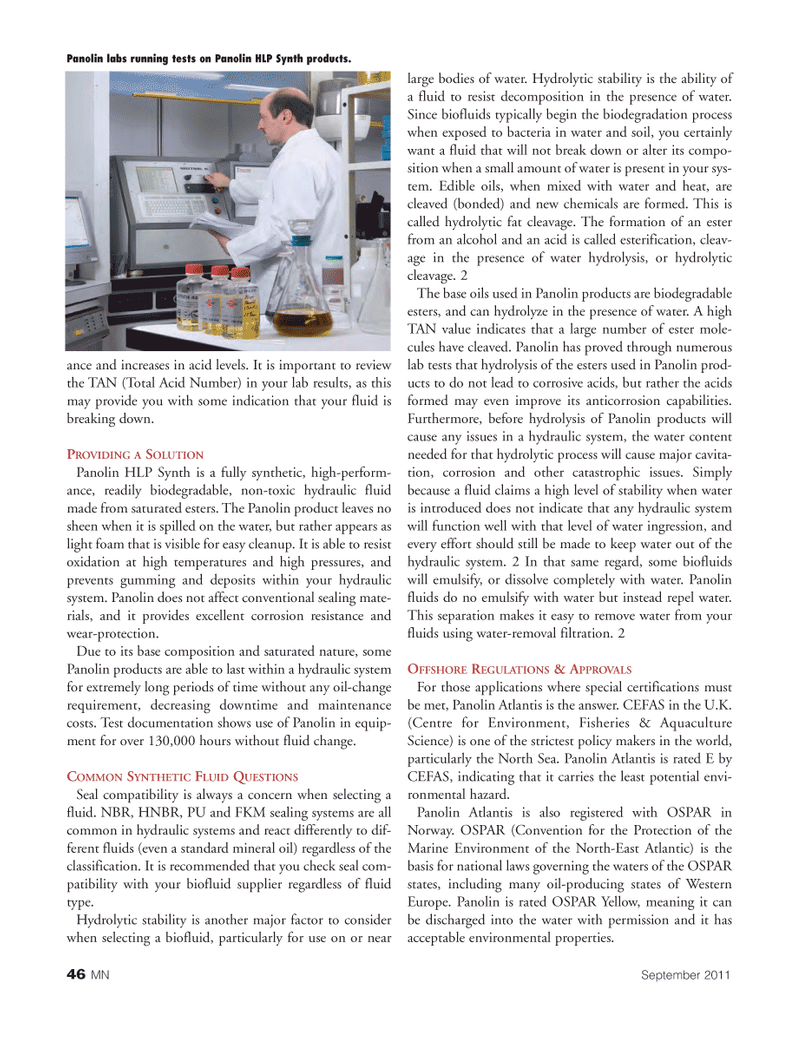
Page 46: of Marine News Magazine (September 2011)
The Environmental Edition
Read this page in Pdf, Flash or Html5 edition of September 2011 Marine News Magazine
46MNSeptember 2011ance and increases in acid levels. It is important to review the TAN (Total Acid Number) in your lab results, as this may provide you with some indication that your fluid is breaking down. PROVIDINGA SOLUTION Panolin HLP Synth is a fully synthetic, high-perform- ance, readily biodegradable, non-toxic hydraulic fluid made from saturated esters. The Panolin product leaves no sheen when it is spilled on the water, but rather appears as light foam that is visible for easy cleanup. It is able to resist oxidation at high temperatures and high pressures, and prevents gumming and deposits within your hydraulic system. Panolin does not affect conventional sealing mate- rials, and it provides excellent corrosion resistance and wear-protection. Due to its base composition and saturated nature, some Panolin products are able to last within a hydraulic system for extremely long periods of time without any oil-change requirement, decreasing downtime and maintenance costs. Test documentation shows use of Panolin in equip- ment for over 130,000 hours without fluid change. COMMONSYNTHETICFLUID QUESTIONSSeal compatibility is always a concern when selecting a fluid. NBR, HNBR, PU and FKM sealing systems are all common in hydraulic systems and react differently to dif- ferent fluids (even a standard mineral oil) regardless of the classification. It is recommended that you check seal com- patibility with your biofluid supplier regardless of fluid type. Hydrolytic stability is another major factor to consider when selecting a biofluid, particularly for use on or near large bodies of water. Hydrolytic stability is the ability of a fluid to resist decomposition in the presence of water. Since biofluids typically begin the biodegradation process when exposed to bacteria in water and soil, you certainly want a fluid that will not break down or alter its compo- sition when a small amount of water is present in your sys- tem. Edible oils, when mixed with water and heat, are cleaved (bonded) and new chemicals are formed. This is called hydrolytic fat cleavage. The formation of an ester from an alcohol and an acid is called esterification, cleav- age in the presence of water hydrolysis, or hydrolytic cleavage. 2 The base oils used in Panolin products are biodegradable esters, and can hydrolyze in the presence of water. A high TAN value indicates that a large number of ester mole- cules have cleaved. Panolin has proved through numerous lab tests that hydrolysis of the esters used in Panolin prod- ucts to do not lead to corrosive acids, but rather the acids formed may even improve its anticorrosion capabilities. Furthermore, before hydrolysis of Panolin products will cause any issues in a hydraulic system, the water content needed for that hydrolytic process will cause major cavita- tion, corrosion and other catastrophic issues. Simply because a fluid claims a high level of stability when water is introduced does not indicate that any hydraulic system will function well with that level of water ingression, and every effort should still be made to keep water out of the hydraulic system. 2 In that same regard, some biofluids will emulsify, or dissolve completely with water. Panolin fluids do no emulsify with water but instead repel water. This separation makes it easy to remove water from your fluids using water-removal filtration. 2 OFFSHOREREGULATIONS & APPROVALS For those applications where special certifications must be met, Panolin Atlantis is the answer. CEFAS in the U.K. (Centre for Environment, Fisheries & Aquaculture Science) is one of the strictest policy makers in the world,particularly the North Sea. Panolin Atlantis is rated E by CEFAS, indicating that it carries the least potential envi- ronmental hazard. Panolin Atlantis is also registered with OSPAR in Norway. OSPAR (Convention for the Protection of the Marine Environment of the North-East Atlantic) is the basis for national laws governing the waters of the OSPAR states, including many oil-producing states of Western Europe. Panolin is rated OSPAR Yellow, meaning it can be discharged into the water with permission and it hasacceptable environmental properties. Panolin labs running tests on Panolin HLP Synth products.MN#9 (32-49):MN 2011 Layouts 9/6/2011 12:28 PM Page 46

 45
45

 47
47
